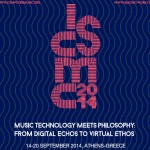Our paper “Effects of different bow stroke styles on body movements of a viola player: an exploratory study” was presented at The joint ICMC|SMC|2014 Conference Athens, Greece, on September 18th 2014. Download the full PDF file.
Abstract
This paper describes an exploratory study of different gestures and body movements of a viola player resulting from the variation of bow strokes length and quantity. Within the theoretical framework of embodied music cognition and the study of musical gestures, we aim to observe how the variation of a musical feature within the piece affects the body movements of the performer. Two brief pieces were performed in four different versions, each one with different directions regarding the bow strokes. The performances were recorded using a multimodal recording platform that included audio, video and motion capture data obtained from high-speed tracking of reflective markers placed on the body of the performer and on the instrument. We extracted measurements of quantity of motion and velocity of different parts of the body, the bow and the viola. Results indicate that an increased activity in sound-producing and instrumental gestures does not always resonate proportionally in the rest of the body and the outcome in terms of ancillary gestures may vary across upper body and lower body.

